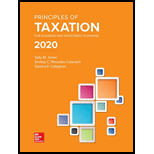
Principles Of Taxation For Business And Investment Planning 2020 Edition
23rd Edition
ISBN: 9781259969546
Author: Sally Jones, Shelley C. Rhoades-Catanach, Sandra R Callaghan
Publisher: McGraw-Hill Education
expand_more
expand_more
format_list_bulleted
Question
Chapter 3, Problem 2AP
a.
To determine
Calculate
b.
To determine
Calculate net present value (NPV).
c.
To determine
Calculate net present value (NPV).
d.
To determine
Calculate net present value (NPV).
Expert Solution & Answer
Want to see the full answer?
Check out a sample textbook solution
Students have asked these similar questions
Susan Mitchell Law Firm purchases $1,000 worth of office equipment on
account. This causes:
A. Cash and Mitchell, Capital to decrease by $1,000
B. Office Equipment and Accounts Payable to increase by $1,000
C. Office Equipment to decrease and Accounts Payable to increase by
$1,000
D. Accounts Payable to increase and Mitchell, Capital to decrease by
$1,000
general account answer need
Please need answer the general accounting question
Chapter 3 Solutions
Principles Of Taxation For Business And Investment Planning 2020 Edition
Ch. 3 - Does the NPV of future cash flows increase or...Ch. 3 - Explain the relationship between the degree of...Ch. 3 - Does the after-tax cost of a deductible expense...Ch. 3 - Prob. 4QPDCh. 3 - Prob. 5QPDCh. 3 - Prob. 6QPDCh. 3 - Prob. 7QPDCh. 3 - Which type of tax law provision should be more...Ch. 3 - In the U.S. system of criminal justice, a person...Ch. 3 - Identify two reasons why a firms actual marginal...
Ch. 3 - Prob. 11QPDCh. 3 - Prob. 12QPDCh. 3 - Prob. 1APCh. 3 - Prob. 2APCh. 3 - Prob. 3APCh. 3 - Use a 5 percent discount rate to compute the NPV...Ch. 3 - Consider the following opportunities: Opportunity...Ch. 3 - Prob. 6APCh. 3 - Refer to the income tax rate structure in the...Ch. 3 - Prob. 8APCh. 3 - Company N will receive 100,000 of taxable revenue...Ch. 3 - Prob. 10APCh. 3 - Investor B has 100,000 in an investment paying 9...Ch. 3 - Firm E must choose between two alternative...Ch. 3 - Company J must choose between two alternate...Ch. 3 - Firm Q is about to engage in a transaction with...Ch. 3 - Corporation ABC invested in a project that will...Ch. 3 - Prob. 16APCh. 3 - Investor W has the opportunity to invest 500,000...Ch. 3 - Prob. 18APCh. 3 - Prob. 19APCh. 3 - Prob. 20APCh. 3 - Prob. 21APCh. 3 - Prob. 1IRPCh. 3 - Firm V must choose between two alternative...Ch. 3 - Prob. 3IRPCh. 3 - Refer to the facts in problem 3. Company WB is...Ch. 3 - Prob. 5IRPCh. 3 - Prob. 6IRPCh. 3 - Prob. 7IRPCh. 3 - Prob. 8IRPCh. 3 - Prob. 9IRPCh. 3 - Prob. 1TPCCh. 3 - Firm D is considering investing 400,000 cash in a...
Knowledge Booster
Similar questions
- Answer? ? Financial accounting questionarrow_forwardThe following data relate to direct materials costs for February: Materials cost per yard: standard, $1.98; actual, $2.04 Standard yards per unit: standard, 4.74 yards; actual, 5.14 yards Units of production: 9,300 Calculate the direct materials price variance. a. $558.00 unfavorable b. $2,644.92 favorable c. $2,868.12 favorable d. $2,868.12 unfavorablearrow_forwardAt October 1, Bonita company reported owners equity of $70,000. During October, the owner made additional investments of $4,300 and the company earned a net income of $13,900. If the owner's equity at October 31 totals $80,700, what amount of owner's drawings were made during the month?arrow_forward
- General Account - At October 1, Bonita company reported owners equity of $70,000. During October, the owner made additional investments of $4,300 and the company earned a net income of $13,900. If the owner's equity at October 31 totals $80,700, what amount of owner's drawings were made during the month?arrow_forwardWhat is the total amount of capital raised on these financial accounting question?arrow_forwardwant general account answerarrow_forward
- Dung Corporation uses the FIFO method in its process costing system. The following data concern the company's Assembly Department for the month of August. Cost in beginning work in process inventory $1,140 Units started and completed this month Cost per equivalent unit Equivalent units required to complete the units in beginning work in process inventory Equivalent units in ending work in process inventory 2,740 Materia Conver Is sion $ 18.55 $ 33.25 260 240 240 94 Required: Determine the cost of ending work in process inventory and the cost of units transferred out of the department during August using the FIFO method.arrow_forwardFinancial accountarrow_forwardJumper Company uses the weighted-average method in its process costing system. The following data pertain to operations in the first processing department for a recent month: Work in process, beginning: Units in process 400 Percent complete with respect to materials 65% Percent complete with respect to conversion 15% Costs in the beginning inventory: Materials cost $1,900 Conversion cost $3,000 Units started into production during the month 14,800 Units completed and transferred out during the month 13,500 Costs added to production during the month: Materials cost $ 77,885 Conversion cost Work in process, ending: $ 25,546 Units in process ? Percent complete with respect to materials 75% Percent complete with respect to conversion 25% What was the cost per equivalent unit for conversion cost?arrow_forward
arrow_back_ios
SEE MORE QUESTIONS
arrow_forward_ios
Recommended textbooks for you
 EBK CONTEMPORARY FINANCIAL MANAGEMENTFinanceISBN:9781337514835Author:MOYERPublisher:CENGAGE LEARNING - CONSIGNMENT
EBK CONTEMPORARY FINANCIAL MANAGEMENTFinanceISBN:9781337514835Author:MOYERPublisher:CENGAGE LEARNING - CONSIGNMENT Cornerstones of Financial AccountingAccountingISBN:9781337690881Author:Jay Rich, Jeff JonesPublisher:Cengage Learning
Cornerstones of Financial AccountingAccountingISBN:9781337690881Author:Jay Rich, Jeff JonesPublisher:Cengage Learning

EBK CONTEMPORARY FINANCIAL MANAGEMENT
Finance
ISBN:9781337514835
Author:MOYER
Publisher:CENGAGE LEARNING - CONSIGNMENT

Cornerstones of Financial Accounting
Accounting
ISBN:9781337690881
Author:Jay Rich, Jeff Jones
Publisher:Cengage Learning
